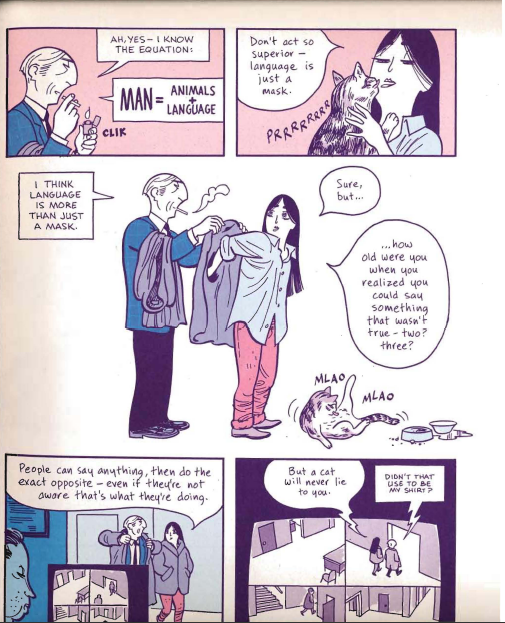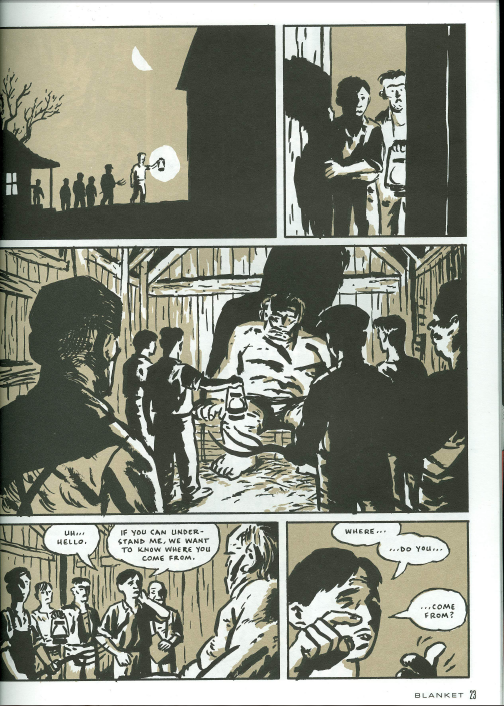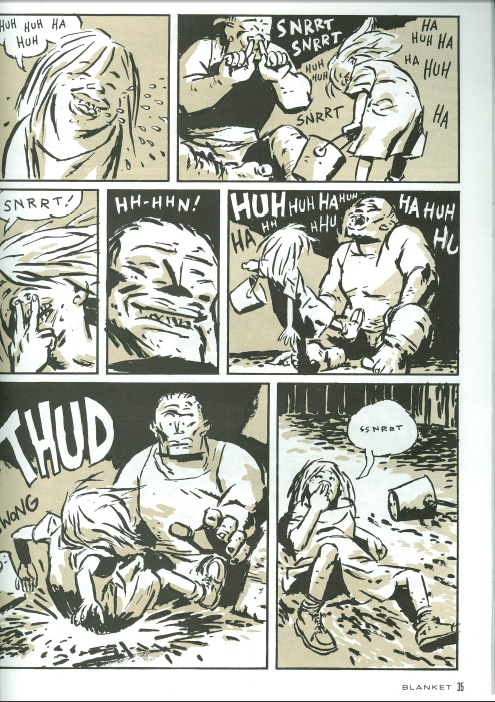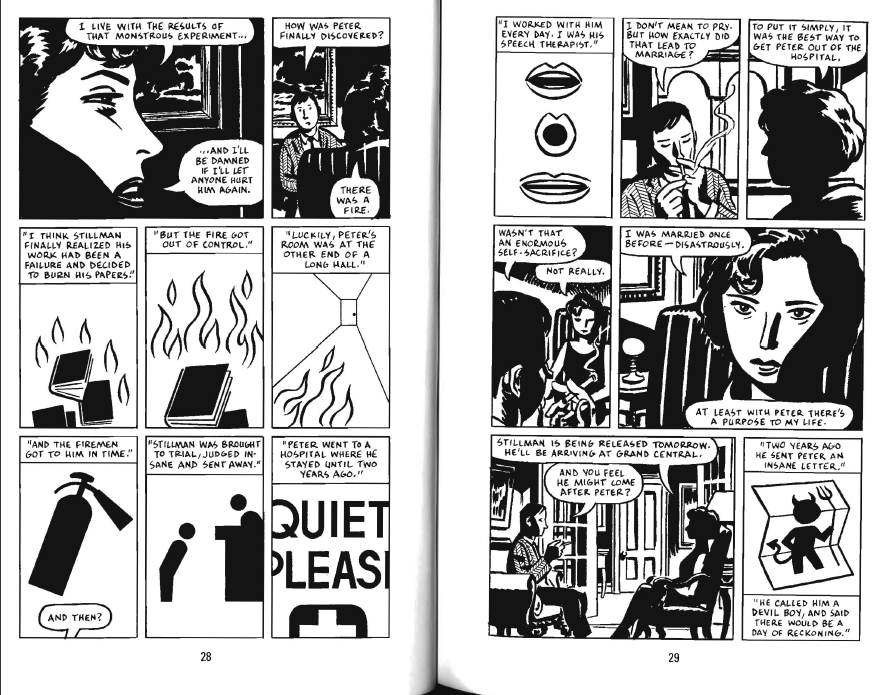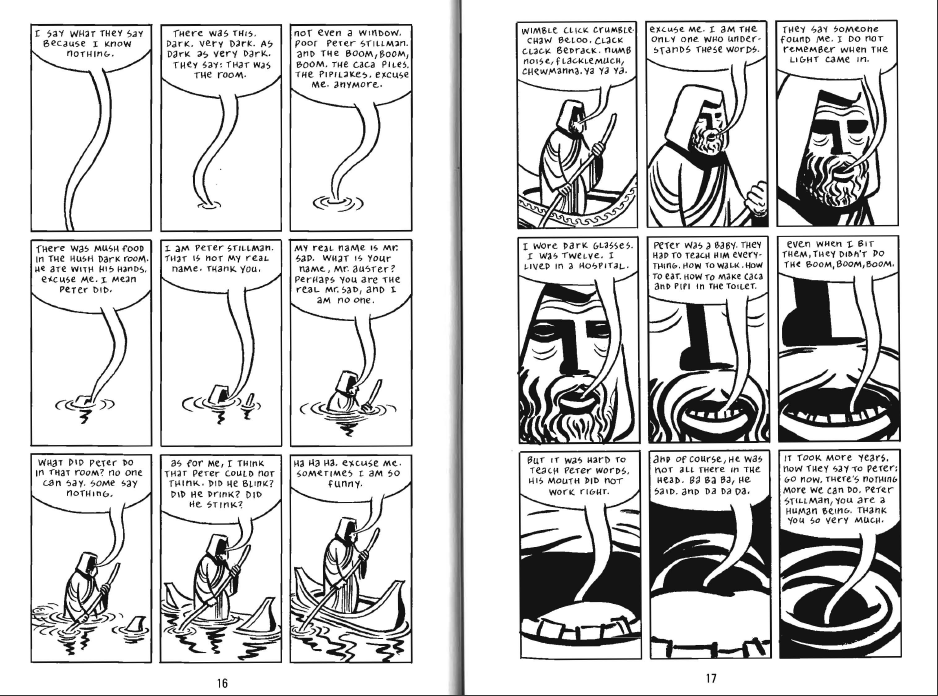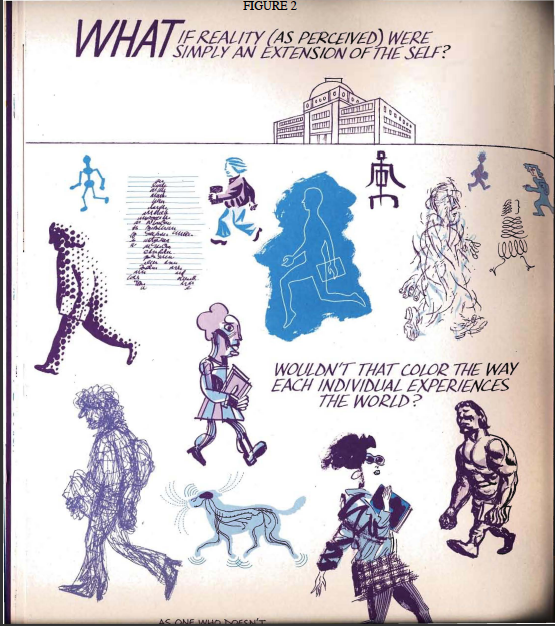The Visual Linguistics of David Mazzuchelli
/I periodically get a chance to teach classes on comics and graphic storytelling. I was able to teach such a subject in Spring 2012 at USC and hope to teach it again here next year. I shared my syllabus for the class at the time. Early on in the class, the challenge is to get students to think more deeply about the range of different devices which comics artists might use to communicate meaning. We were lucky this most recent time to have a really rich essay on this topic which Randy Duncan wrote for Critical Approaches to Comics, which was our principal textbook. Duncan's essay uses David Mazzuchelli, Asterios Polyp as its primary example. This book turned out to be an eye-opener for many of my students, because of its diverse range of visual symbols, its expressive use of color, and its diverse ways of deploying typefaces to capture the different communication styles of the various characters. Mikhail Skoptsov, then a Cinema School graduate student who was taking the class, was inspired to dig deeper into David Mazzuchelli's work and developed an argument about the persistent interest throughout many of his stories in exploring the challenges characters face in communicating with each other. Skoptsov, now a student in the Media and Cultures program at Brown, has continued to revise this essay and I am delighted to have a chance to share it with you today. My own sense is that it sheds some important light both on Mazzuchelli and on the "language" of comics more generally. Enjoy.
The Visual Linguistics of David Mazzuchelli
by Mikhail Skoptsov
After working on a number of high-profile projects, such as Batman: Year One and Daredevil: Born Again, David Mazzuchelli broke away from superhero comics to self-publish the magazine Rubber Blanket. Despite lasting only three issues, the publication showcased works that Mazzuchelli had fully scripted and illustrated all by himself, forming some of the recurring techniques, themes and motifs he would later apply to his co-adaptation of Paul Auster’s City of Glass (1994) with Paul Karasik and his original masterpiece Asterios Polyp (2009). I would argue that these three works evince that Mazzuchelli is a modern graphic novel auteur, who repeatedly explores issues of language and communication. To prove this, I will examine the aforementioned two novels and the short story Big Man from Rubber Blanket #3.
I will begin by analyzing a scene from Big Man, whose titular character is a mysterious giant that washes up on a riverbank, one day, to the consternation of a rural farming community. When Peter, a farmer, tries to unsuccessfully speak with Big Man, he realizes that the giant doesn’t understand English. In the first of the two bottom panels on page 23, Peter says to Big Man: “If you can understand me, we want to know where you come from.” (23). In the next panel, Peter tries to use hand gestures to clarify the meaning of his words. This time he speaks slowly, placing pauses between his words: “Where… do you… come from?” On the first panel of page 24, the Big Man responds with the sound “Hhhn?”, while mimicking with his hands the action of writing. By doing this, he physically expresses a desire to have something to write with.
Subsequently, we see Peter hand him a file clipper and a pencil in the next couple of panels, evincing that he understood the gesture. Big Man then begins to write. When panel 6 reveals the Big Man’s text, it turns out that Big Man’s writing is indecipherable, as it appears in the form of signs that resemble hieroglyphics, which Peter, the other farmers and the readers cannot understand. This establishes that Big Man normally speaks and writes in a language that is unfamiliar to normal people.
Thus, this series of panels juxtaposes the Big Man’s ability to communicate physically through gesture with his inability to communicate verbally and through writing. Through the juxtaposition, Mazzuchelli proposes the idea that language can be physical, that it does not necessarily have to consist of spoken words and written text. In other words, he espouses an alternate way of communicating. Supporting this idea is the fact that Big Man never utters a word via ‘speech balloons’ or ‘word bubbles’, which represent the traditional means of visualizing dialogue between characters in comics. This is clearly visible in panel 8 on page 34 and panel 2 on page 35, where the little speech-impaired girl Rebecca successfully communicates with Big Man without verbally forming words and sentences.
Instead, as we can see in panels 3 and 4 on page 35, both of them utilize the nasal sound “Snrrt!” to speak to each other. Though they pronounce the same noise, Rebecca’s appears within white speech balloons, designating it as ‘dialogue’, while the Big Man’s “Snrrt” appears outside of a balloon, placing it in line with other noises such as the “THUD” in panel 6. The fact that “Snrrt” appears as both dialogue and noise illustrates that noise can have the same communicative function as dialogue. This positions noise as a viable means of communication, an alternative to speech and writing. Another possible interpretation could be that noise functions as a language, where a single sound can stand in for entire words or sentences.
One could construe the fact that Big Man and Rebecca converse using only “Snrrt” as them speaking a language only they understand. One doesn’t know exactly what Big Man and Rebecca mean by pronouncing “Snrrt!”, but the two apparently understand one another, as they use the sound repeatedly. As such, language becomes intrinsic not just to the plot and story of Big Man, but also to the perception of the titular character by the other characters and by the readers. Language essentially defines Big Man as a character, portraying him as an ‘other’ to the farmers and a familiar to Rebecca.
Language similarly defines the character of Peter Stillman, the reclusive billionaire of City of Glass, who hires main character Daniel Quinn to investigate Peter’s abusive and insane father. Quinn learns that Stillman Senior’s insanity apparently came about as a result of his research on language and religion. As Quinn’s narration indicates, Stillman believed that the fall of man from Paradise brought about the fall of language. After the fall, language “…had been severed from God.” (Karasik and Mazzuchelli 39) The idea of creating a new language or recovering the old language became a driving force for Stillman Sr., which he confirms to Quinn in a park conversation in the last panel on page 69. Thus, Mazzuchelli portrays language in City of Glass as part of one’s identity, as well as a source of character motivation. It can function not just as a means of communication, but as an extension of the characters.
Strengthening this view is the author’s visualization and foregrounding of communi-cation though an expressive utilization of text and word balloons, as well as the combination of words with abstract images. City of Glass first creates the impression that it abides by the traditional visualization of dialogue in graphic novels, wherein all the letters appear in the same font and the same size. For example, in the second panel of page 28, Quinn asks Stillman’s wife Virginia: “How was Peter finally discovered?” Virginia responds: “There was a fire”. Both lines of dialogue appear in spherical speech balloons with all letters in uppercase and in the same font. The majority of conversations within the novel utilize this style.
On the one hand, this establishes the font and speech balloon format Quinn and Virginia speak in as the ‘common’ format of the novel. On the other, this serves to distinguish the sequences, where conversations diverge from this format, which the scene that introduces Stillman Jr illustrates perfectly. When he begins to talk on page 15, the reader should immediately notice that Peter’s dialogue is visually different from that of the other characters. For one thing, his words mix lower and uppercase letters. The word “Peter” for example, capitalizes the “P” and the “T” while leaving the rest of the letters in lowercase. Such an amalgamation suggests that Peter speaks in an inconsistent, disorderly manner, in comparison to the other characters, who speak normally.
For another, Peter’s word balloon reaches deeply into his mouth, in stark contrast to the previous word balloons in the book, all of which appear at a distance from the mouth of the character, whose words they are conveying. This distinct visual presentation gives the impression that the balloon is a part of Peter himself, a natural extension of his character. Compounding this impression are the subsequent panels, which continue to display the word balloons literally emerging from inside Peter, each new panel closing the distance between Peter’s mouth and the frame. The second panel moves towards a medium close-up, the third to a close-up. This continues until the ninth and final panel has literally entered deep inside the throat of Stillman, which resembles an endless black-and-white spiral.
The word balloon continues to emerge from inside the spiral, the pattern making it appear, as if the panels have been following the spiral to its source. This continues in the 3x3 panels from pages 16-23, which display various surreal and abstract images, including a puddle of water (16), a gondolier (17), a grate (19), a bird (20) and a guitar (21). Multiple panels sometimes display the same image, only at different angles, with the gondolier occupying 15 panels from pages 16 and 17. All of the panels feature Peter’s word balloon emerging from the image and resuming his dialogue.
For example, Peter says in panel 9 of page 15: “…They say mother died.” On the next page, the frame displays the word balloon, reaching below the frame, continuing: “I say what they say because I know nothing.” The next panel shows the balloon coming from a puddle, continuing: “There was this. Dark. Very dark…” This combination of images signifies that Peter is the one speaking at all times. He remains the source of the dialogue. However, the reader sees different visual representations of the source/Peter. Thus, the use of multiple visual sources implies a continuous shift in Peter’s manner of speaking. The order of the images seems random and the lack of an identifiable pattern indicates that Peter has no control over what he says, his words essentially transmitting a stream of consciousness.
Additionally, Peter’s sentences can come off as incoherent, full of sudden changes of subject without a logical reason. As the aforementioned three lines of dialogue attest, after talking about the death of his mother, he suddenly and inexplicably shifts towards speaking about the dark room he was in as a child. Altogether, the mixing of uppercase and lowercase letters, the incoherent sentences and the different visual representations of Peter speaking express the idea that Peter is mentally unstable. He himself confirms his instability when he says: “I know that all is not right in my head” (21) As such, Mazzuchelli ultimately depicts communication expressionistically to visualize a character’s interiority to the reader.
Peter’s unique way of speaking/communicating distinguishes him from everyone else within the context of the novel. Thus, the image of the word balloon reaching literally inside him connotes that language is a part of him, an extension of his self. The plot confirms this by positioning Stillman Sr.’s search for language as the cause of his insanity. It compelled him to lock his son alone in a room for 9 years (Karasik and Mazzuchelli 27), ultimately leading to Peter’s mental instability.
Mazzuchelli expands on the idea of language functioning as one’s extension in Asterios Polyp by depicting every single character with a particular text font and speech balloon. To illustrate this, I present Figure 1, which features a sequence from the book between Asterios and his wife Hana, as they try to tell a story to a group of unseen interlocutors in a restaurant. Asterios’ text appears in all six panels in rectangular polygons, while his words are always uppercase, never lowercase, italicized or bold. The rectangular form of his speech balloons reflects his status as a professor of architecture and his preference for, as well his interest solids and rectangular flats. Meanwhile, while the use of solely uppercase letters reflects his aversion to change and his preference for rigid order and structure.
Hana, by contrast, speaks in spherical word balloons and her dialogue uses both uppercase and lowercase letters. This places her in direct opposition to Asterios visually, reflecting her down-to-Earth personality, her openness to change and her interest in non-rectangular figures, such as circles and straight lines, as she herself mentions towards the end of the book. Like in City of Glass, the text frame also functions in an expressive manner. For instance, the third panel portrays Asterios’ hexagonal speech box in the foreground, relegating Hana’s spherical speech bubble to the background.
As Hana describes how “…this one big guy tries to push…”, Asterios interjects with his addition: “Before that though, a couple of women squeezed in front of him.” Instead of telling the viewers via narration that Asterios interrupts Hana, Mazzuchelli depicts this through image and composition by visualizing Asterios’ box over Hana’s bubble. Through this, he additionally conveys Asterios’ egocentrism, his belief that he knows better than Hana. Hence, the text font and the text frame visually define and contrast the characters’ personalities, as well as convey how the characters speak, as opposed to just what they say.
By portraying everyone in the novel with his/her own particular text font and/or frame, Mazzuchelli illustrates that every person has an individual manner of speaking. Thus, the manner of speech becomes an extension of the character. This goes in hand with how the author describes language in Figures 2 and 3. Figure 2 opens with a narration. It states: “What if reality (as perceived) were simply an extension of the self? Wouldn’t that color the way each individual experiences the world?” The images on Figure 2 depict numerous people in a variety of art styles. Thus, the association of word and image indicates that the art styles all represent the different ways that individuals can experience the world.
If one’s perception of reality is an extension of one’s self and one’s manner of speaking is an extension of the self, then, by illustrating how every individual has a distinct manner of speaking, Mazzuchelli conveys that every individual has a different manner of perceiving reality. In Figure 3, the narration continues: “That might explain why some people get along so effortlessly…”. Images of men and women, drawn in an identical art style, appear next to it. In conjunction with the previous figure, the identical art style indicates that these men and women experience the world in a similar manner. The narration indicates that the images represent the people that get along easily, evincing that people who have similar perceptions of reality can effortlessly get along with one another.
Conversely, the characters in the next two images appear in different styles and the narration concludes with: “…while others don’t.” The association of these words with the images signifies that these characters perceive the world differently. So, they do not get along easily. Finally, the author presents two different characters speaking in one overlapping speech bubble. The words inside all say “Hello” in three different languages: English, Hawaiian and Hebrew. The narration below the image refers to the previous statement of people getting along: “Although people do keep trying.” Mazzuchelli associates the act of speaking, the act of verbal communication with individuals getting along or finding a common way of experiencing the world, as the overlapping speech bubble indicates.
This means that if language is key to verbal communication between different individuals, then language can be a means for people to find a common way of experiencing the world. While every character in the novel possesses a distinct style of speech and a unique perception of reality, the English language remains the one constant between them all. So, language becomes an extension of every single character within Asterios Polyp, functioning as an intermediary bet-ween the various individuals’ different perceptions of reality, allowing them to arrive at a unified perception. Together with the examples from Big Man and City of Glass, this proves that Mazzu-chelli is an auteur that visually foregrounds language and communication in comic form.
Overall, we can see that Mazzuchelli emphasizes language and communication throughout his body of work. By expressively using the text, the author helps define his characters through their manner of speech and their use of language. In addition, he raises various questions about how and why people communicate, about what language is and what its functions are. If communication is usually an unobtrusive and inexpressive element of mainstream graphic novels, it is a visible and distinguishing characteristic of the oeuvre of Mazzuchelli. So it isn’t surprising that Mazzuchelli and co-author Paul Karasik compared the adaptation of the novel City of Glass into a graphic novel to “… a translation from one language to another” (Kartalou-polos). In this regard, one could consider Mazzuchelli a graphic novel linguist.
Citations
Karasik, Paul and Mazzuchelli, David. City of Glass, The Graphic Novel. Picador, New York 2004. Revised version of Neon Lit: Paul Auster’s City of Glass, Avon Books, 1994. Based on the novel City of Glass by Paul Auster, Sun and Moon Press, 1985.
Kartaloupolos, Bill. “Three Questions for David Mazzucchelli” in Indy Magazine, Spring 2004. http://www.indyworld.com/indy/spring_2004/mazzucchelli_interview/index.html
Mazzuchelli, David. Asterios Polyp. Pantheon Books, New York, 2009
Mazzuchelli, David. “Big Man” in Rubber Blanket #3. Ed. David Mazzuchelli and Richmond Lewis, Rubber Blanket Press, Hoboken NJ, 1993, 17-64
Mikhail Leonidovich Skoptsov is currently a second semester PHD student at Brown University's department of Modern Culture and Media. He has a BA in Cinema Studies from New York University and an MA in Film Studies from the University of Southern California. His current research interests include: postmodernism in cinema, media piracy, fan productions, serialization in cinema and television, as well as trans-media storytelling.

